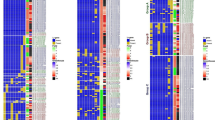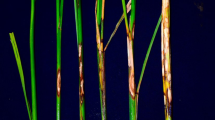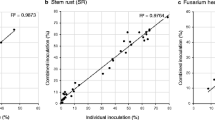Abstract
A sample of 200 accessions was selected from IRRI’s rice (Oryza sativa) germplasm bank, that represents rice diversity in terms of genetic groups (aus, indica, tropical japonica, temperate japonica, and aromatic) and crop duration cycles of the accessions. The sample also captured the diversity of rice germplasm in terms of morphological traits. The accessions were assessed for their level of susceptibility to sheath blight in a field experiment, by inoculating hills at the centre of microfields and measuring disease intensity. Morphological traits of all accessions were also measured. Analyses of variance indicated significant effects of genetic groups and genotypes on sheath blight intensity, measured by different variables (lesion height, relative lesion height, leaf severity, sheath severity, and disease incidence on tillers). Results from multivariate analyses (canonical correlation, hierarchical cluster analyses, correspondence analysis, and discriminant analysis), and logistic regressions indicated that morphological traits were strongly associated with disease intensity, and that their effect was larger than that of genetic groups. In particular, plant height was associated with low sheath blight intensity. Effects of genetic groups could however also be detected, and the combination of results suggested a ranking of genetic groups with increasing level of susceptibility to sheath blight as: aus < indica < japonica.






Similar content being viewed by others
References
Agresti A (2002) Categorial data analysis, 2nd edn. Wiley, Hoboken
Benzécri JP (1973) L’Analyse des Données. Tome 2. L’Analyse des Correspondances. Dunod, Paris
Bioversity International, IRRI and WARDA (2007) Descriptors for wild and cultivated rice (Oryza spp.)
Butt DJ, Royle DJ (1980) The importance of terms and definitions for a conceptually unified epidemiology. In: Palti J, Kranz J (eds) Comparative epidemiology. A tool for better disease management. Pudoc, Wageningen, pp 29–45
Castilla NP, Leano RM, Elazegui FA, Teng PS, Savary S (1996) Effects of plant contact, inoculation pattern, leaf wetness regime, and nitrogen supply on inoculum efficiency in rice sheath blight. J Phytopathol 144:187–192
Dagnelie P (1975) Analyse statistique a plusieurs variables. Les presses agronomiques de Gembloux. Gembloux, Belgique
Fisher L, Van Ness JW (1971) Admissible clustering procedures. Biometrika 58:91–104
Garris AJ, Tai TH, Coburn J, Kresovich S, McCouch S (2005) Genetic structure and diversity in Oryza sativa L. Genetics 169:1631–1638
Glaszmann JC (1987) Isozymes and classification of Asian rice varieties. Theor Appl Genet 74:21–30
Gomez KA, Gomez AA (1975) Statistical procedures for agricultural research, 2nd edn. Wiley, New York
Greenacre MJ (1984) Theory and applications of correspondence analysis. Academic Press, London
Harrell FE Jr (2001) Regression modeling strategies: with applications to models, logistic regression, and survival analysis. Springer-Verlag, New-York
IRGCIS (2010) http://www.irgcis.irri.org:81/grc/irgcishome.html. Accessed 8 July 2010
IRRI, IBPGR (1980) Descriptors for rice Oryza sativa L. IRRI, Los Baños, p 21
Lebart L, Morineau A, Fénelon JP (1982) Traitement des Données Statistiques. Méthodes et Programmes. Dunod, Paris
McNally KL, Manzano R, Macatangay M, Redondo M, Lacorte V, Zaidem M, Detras J, Barile M, Angeles R, Quilloy S, Gamalinda M, Sancinagco M, Pabale D, Sackville Hamilton NR, Benoit L, Rivallan R, Courtois B, Billot C, Garavito A, Lorieux M, Martinez CP, Borba T, Brondani RV, Brondani C, Cissoko M, Ndjiondjop MN, Famoso A, McCouch SR (2007) Population structure of the rice composite set. Generation challenge programme annual research meeting, September 2007, Benoni, Poster Abstracts, p. 25. http://www.generationcp.org/UserFiles/File/Abstracts.pdf
Mew TW (1991) Disease management in rice. In: CRC handbook of pest management in agriculture, 2nd edn, vol III. CRC Press, Inc. Boca Raton, Ann Arbor, pp 279–299
Ou SH (1985) Rice diseases, 2nd edn. Commonwealth Mycological Institute, Surrey
Parlevliet JE, Van Ommeren A (1975) Partial resistance of barley to leaf rust: Puccinia hordei. II. Relationship between field trials microplot tests and latent period. Euphytica 24:293–303
Pinson SRM, Capdevielle FM, Oard JH (2005) Confirming QTLs and finding additional loci conditioning sheath blight resistance in rice using recombinant inbred lines. Crop Sci 45:503–510
Poland JA, Balint-Kurti PJ, Wisser RJ, Pratt RC, Nelson RJ (2009) Shades of gray: the world of quantitative disease resistance. Trends Plant Sci 14:21–29
Robinson RA (1976) Plant pathosystems. Springer, Berlin
Sackville Hamilton NR, Skøt L, Chorlton KH, Thomas ID, Mizen S (2002) Molecular genecology of temperature response in Lolium perenne: preliminary analysis to reduce false positives. Mol Ecol 11:1855–1863
Savary S, Mew TW (1996) Analyzing crop losses due to Rhizoctonia solani: rice sheath blight, a case study. In: Sneh B, Jabaji-Hare S, Neate S, Dijst G (eds) Rhizoctonia species taxonomy, molecular biology, ecology, pathology and disease control. Kluwer Academic Publishers, Dordrecht, pp 237–245
Savary S, Bosc JP, Noirot M, Zadoks JC (1988) Peanut rust in West Africa: a new component in a multiple pathosystem. Plant Dis 72:1001–1009
Savary S, Castilla NP, Elazegui FA, McLaren CG, Ynalvez MA, Teng PS (1995) Direct and indirect effects of nitrogen supply and disease source structure on rice sheath blight spread. Phytopathology 85:959–965
Savary S, Elazegui FA, Teng PS (1996) A survey portfolio for the characterization of rice pest constraints. IRRI Discussion Papers Series no. 18. IRRI, Los Baños
Savary S, Willocquet L, Elazegui FA, Castilla N, Teng PS (2000) Rice pest constraints in tropical Asia: quantification and yield loss due to rice pests in a range of production situations. Plant Dis 84:357–369
Sharma NR, Teng PS (1990) Effect of inoculum source on sheath blight development. Int Rice Res Newsl 15:20–21
Shrestha CL, Oña I, Muthukrishnan S, Mew TW (2008) Chitinase levels in rice cultivars correlate with resistance to the sheath blight pathogen Rhizoctonia solani. Eur J Plant Pathol 120:69–77
Srinivasachary, Willocquet L, Savary S (2011) Resistance to rice sheath blight (Rhizoctonia solani Kühn) [(teleomorph: Thanatephorus cucumeris (A.B. Frank) Donk.] disease: current status and perspectives. Euphytica 178:1–22
Teng PS, Torres CQ, Nuque FL, Calvero SB (1990) Current knowledge on crop losses in tropical rice. In: Crop loss assessment in rice, IRRI, Philippines, pp 39–54
Van der Plank JE (1978) Genetic and molecular basis of plant pathogenesis. Springer, Berlin
Wilkinson L, Engelman L, Corter J, Coward M (2007) Cluster analysis. In: Statistics I. SYSTAT Software, Inc. San Jose, pp I-65–I-124
Yang XB, Snow JP, Berggen GT (1991) Patterns of Rhizoctonia foliar blight on soybean and effect of aggregation on disease development. Phytopathology 81:287–293
Zadoks JC, Schein RD (1979) Epidemiology and plant disease management. Oxford University Press, New York
Zuo S, Zhang L, Wang H, Yin Y, Zhang Y, Chen Z, Ma Y, Pan X (2008) Prospect of the QTL-qSB-9Tq utilized in molecular breeding program of japonica rice against sheath blight. J Genet Genomics 35:499–505
Acknowledgments
We wish to thank M. Banasihan, JS. Bigornia, N. Castilla, F. de Guzman, W. Lanip, NJ. Magculia, I Mamiit, L. Matundan, E. Pizarra, D. Salisi, and E. Silab for their technical assistance. We are grateful to Miss Grace Centeno (IRRI Climate Unit) for providing the weather data. This work was partly supported by the Bill & Melinda Gates Foundation under the Cereal System Initiative for South Asia Project.
Author information
Authors and Affiliations
Corresponding author
Rights and permissions
About this article
Cite this article
Willocquet, L., Noel, M., Sackville Hamilton, R. et al. Susceptibility of rice to sheath blight: an assessment of the diversity of rice germplasm according to genetic groups and morphological traits. Euphytica 183, 227–241 (2012). https://doi.org/10.1007/s10681-011-0451-9
Received:
Accepted:
Published:
Issue Date:
DOI: https://doi.org/10.1007/s10681-011-0451-9




